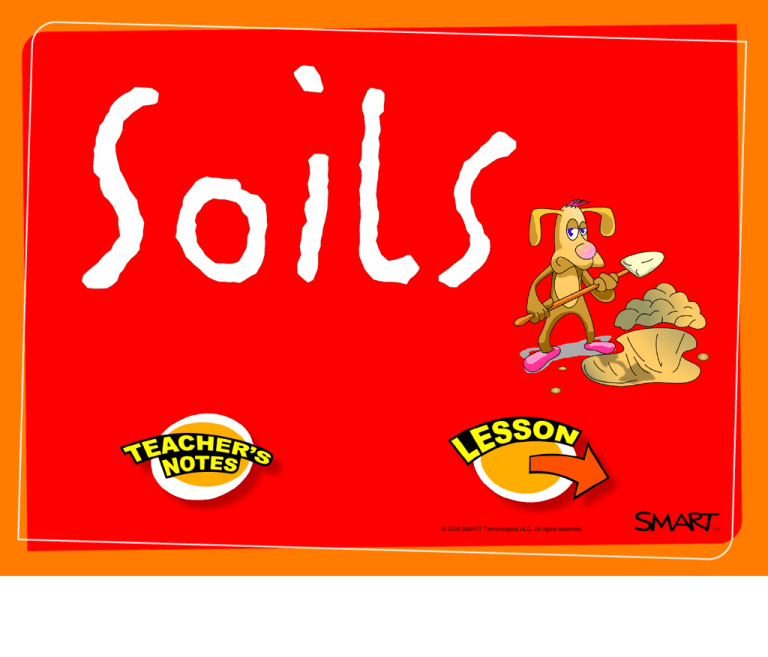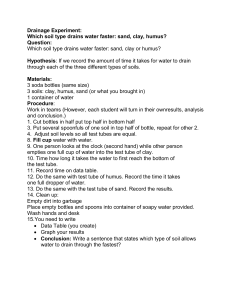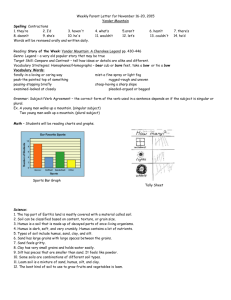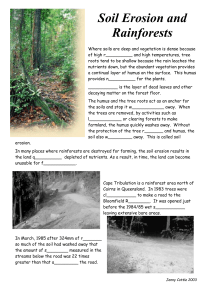
© 2009 SMART Technologies ULC. All rights reserved.
Essential
Concepts
Soil Matrix
Soil Diagram
Then you may complete the
anticipation guide on the
essential concepts.
Circle
Map
Plants need soil to grow.
What else do you know about
soil?
more
Share your ideas with
the class.
Soil
Different soils have different colors.
reveal
Look at the colors of humus, sand,
and clay. What kind of soil has each
color?
loam
sand
clay
Different soils have different
textures.
Match each type of soil to its
texture.
gritty
humus
smooth
sand
medium
clay
Some soils drain more quickly
or more slowly than others.
Which soil drains more quickly?
More slowly?
sand
drains
slowly
loam
clay
drains
quickly
Different kinds of plants grow best
in different kinds of soil.
Match the plants to the soil they
grow best in.
sand
humus
Let's Review!
Soil is...
found on the ground
dirty
brown
plants need it
worms live in it
has rocks and pebbles in it
sand
loam
Let's Make Some QUALITATIVE Observations!
Clay
Humus
Sand
Silt
Use your observations to
complete this chart in your
journals.
Type of Soil
Looks Like:
Feels like:
______________
Color: White or tan
Rough
Texture: Can easily see
grains
______________
Color: Dark brown or
black
Texture: Has some
clumps, can see some
grains
Smooth
______________
Color: Red
Texture: Clumps
together easily, cannot
see individual grains
Very soft and smooth
COMPARE!
End of Tuesday
You're the scientist today!
Get ready to get down and
dirty!
Can
Soil
Hold
Water?
Let's prepare for our investigation!
Objective:
To determine how well different soils hold water.
Hypothesis:
Materials:
You decide!
Data:
Filters, Graduated cylinder, cups, water, sand, humus, clay,
calculator
Put your calculations and observations here!
Our Procedures
1.
Put a coffee filter in an empty cup, and overlap the sides of the filter over the cup sides
2.
Put 1 ounce of soil inside the coffee filter.
3.
Measure 30 mL of water with the graduated cylinder.
4.
Pour the water over the soil.
5.
Measure the water that drains through the filter with the graduated cylinder.
6.
Subtract the amount from 30 mL to find out how much water their soil held.
7.
Put this amount in a chart on the board created by the teacher.
8.
Copy the chart in their journal and fill in the information as groups report to the board.
9.
Find the average with a calculator. (Add all the numbers in one column and divide by
the number of numbers you added together.) Example: 100+90+80=270, Then 270/3=90. So
my average is 90.
10.
Analyze the results.
Can Soil Hold Water?
Sand
Humus
Clay
Group One
Group Two
Group Three
Average:
(Remember to subtract the amount of water that drained through the soil from 30 mL to find out how many milliliters your soil held.)
Conclusion:
Reflection Question:
Two geraniums are planted in two different types of
soil (humus and clay). Tell how the geraniums will
change after two weeks in each soils. Which will
have a better chance of survival? Why?







